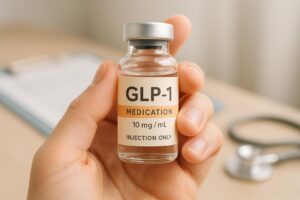Is Semaglutide the Same as GLP-1?

The rise of weight management solutions has changed the landscape of healthcare, particularly with medications that target obesity. Among these, semaglutide has gained significant attention. But an important question arises: is semaglutide the same as GLP-1? To provide clarity, let’s explore the science behind semaglutide, its role as a glucagon-like peptide-1 (GLP-1) receptor agonist, and its applications in weight management.
Introduction
In a world where obesity affects millions and is linked to various health complications, the search for effective weight loss solutions is more critical than ever. According to the Centers for Disease Control and Prevention (CDC), over 42% of American adults are classified as obese. This statistic emphasizes the urgent need for innovative treatments that can assist individuals in achieving and maintaining a healthy weight.
Semaglutide is one such treatment that has emerged as a beacon of hope for many. Originally developed to manage type 2 diabetes, semaglutide has shown remarkable efficacy in promoting weight loss, leading to its approval as a weight management solution under the brand name Wegovy. However, understanding the nuances of semaglutide and its classification as a GLP-1 receptor agonist is essential for grasping its mechanism of action and potential benefits.
In this blog post, we will delve into the relationship between semaglutide and GLP-1, exploring what makes semaglutide unique, how it operates within the body, and the implications for those pursuing weight loss. We will also discuss safety, efficacy, and the importance of personalized care in weight management. By the end, readers will have a comprehensive understanding of whether semaglutide is synonymous with GLP-1 and how it fits into the broader narrative of obesity management.
Understanding GLP-1 and Its Role in the Body
What is GLP-1?
GLP-1, or glucagon-like peptide-1, is a hormone produced in the intestines in response to food intake. It plays a crucial role in glucose metabolism and appetite regulation. GLP-1 functions as an incretin hormone, enhancing insulin secretion, reducing glucagon secretion, and slowing gastric emptying, which collectively help lower blood glucose levels.
The Mechanism of Action of GLP-1
The biological actions of GLP-1 occur in several ways:
- Stimulating Insulin Secretion: GLP-1 increases insulin release from the pancreas when glucose levels are elevated.
- Inhibiting Glucagon Release: By suppressing glucagon, GLP-1 helps to prevent blood sugar spikes.
- Slowing Gastric Emptying: This action leads to prolonged satiety, which can help reduce overall calorie intake.
- Promoting Satiety: GLP-1 sends signals to the brain, enhancing feelings of fullness and reducing appetite.
Why is GLP-1 Important for Weight Management?
The appetite-suppressing effects of GLP-1 are particularly significant in weight management. By regulating hunger signals and enhancing satiety, GLP-1 helps individuals consume fewer calories, making it an attractive target for obesity treatments.
Semaglutide: The GLP-1 Receptor Agonist
What is Semaglutide?
Semaglutide is a synthetic analogue of GLP-1, designed to mimic the hormone’s functions while offering a longer duration of action. Unlike natural GLP-1, which is rapidly degraded by enzymes in the body, semaglutide is more resilient, allowing it to remain active for an extended period. This characteristic makes it effective for managing both blood sugar levels and body weight.
How Does Semaglutide Work?
As a GLP-1 receptor agonist, semaglutide binds to GLP-1 receptors throughout the body, initiating similar physiological responses. Its effects include:
- Enhanced Insulin Secretion: Like GLP-1, semaglutide stimulates insulin release from the pancreas when glucose is present.
- Reduced Glucagon Levels: By inhibiting glucagon, semaglutide helps maintain lower blood glucose levels.
- Decreased Appetite: Semaglutide promotes satiety, leading to reduced food intake over time.
Comparing Semaglutide to Other GLP-1 Agonists
Semaglutide is part of a broader class known as GLP-1 receptor agonists, which also includes medications like liraglutide (Victoza) and dulaglutide (Trulicity). While all these medications share similar mechanisms, semaglutide has been shown to produce more significant weight loss compared to its counterparts. In clinical trials, participants using semaglutide experienced an average weight loss of about 15% of their body weight, demonstrating its effectiveness as a weight-loss solution.
The Role of Semaglutide in Weight Management
FDA Approval and Indications
In 2021, semaglutide received FDA approval for chronic weight management under the brand name Wegovy. It is indicated for adults with a body mass index (BMI) of 30 or greater, or a BMI of 27 or greater with at least one weight-related comorbidity. This approval reflects a shift in recognizing obesity as a chronic disease that requires medical intervention rather than solely lifestyle changes.
Clinical Efficacy of Semaglutide
Clinical trials have consistently shown that semaglutide not only aids in weight loss but also improves markers of health associated with obesity, such as blood pressure and cholesterol levels. Participants in studies often reported significant improvements in their overall health, leading to a reduced risk of obesity-related complications.
Safety and Side Effects
While semaglutide presents a promising option for weight management, it’s important to consider potential side effects. Common side effects include:
- Nausea
- Vomiting
- Diarrhea
- Abdominal pain
- Constipation
These symptoms are typically mild and tend to diminish over time as the body adjusts to the medication. However, it’s essential for individuals to consult with healthcare professionals before starting semaglutide, ensuring that it fits into their overall treatment plan.
Personalized Care at TrimRx
At TrimRx, we believe that effective weight management should be personalized and medically supervised. Our approach integrates cutting-edge telehealth innovations with comprehensive care, ensuring that each individual receives tailored support throughout their weight loss journey. We provide a free assessment quiz that helps determine eligibility for prescription weight loss medications, including semaglutide. By leveraging our personalized weight loss program, individuals can embark on a journey toward sustainable weight loss with compassionate guidance.
Ready to see if semaglutide is right for you? Take our free assessment quiz here.
The Importance of a Holistic Approach
Combining Semaglutide with Lifestyle Changes
While semaglutide can lead to significant weight loss, it’s important to remember that medication alone is not a silver bullet for obesity. For long-term success, individuals should also focus on adopting healthy lifestyle changes, including:
- Balanced Diet: Incorporating nutrient-dense foods and reducing processed items can enhance weight loss efforts.
- Regular Exercise: Engaging in physical activity not only aids in weight loss but also improves overall health.
- Behavioral Modifications: Working with a dietitian or a healthcare professional can provide strategies to develop healthy habits and address emotional eating.
The Role of Support
Support is crucial in any weight loss journey. Whether through a healthcare provider, a support group, or a community, having encouragement can significantly impact adherence to lifestyle changes and medication regimens. At TrimRx, we offer unlimited support to our clients, ensuring they have the resources and motivation needed to succeed.
Conclusion
In summary, semaglutide is a powerful tool in the management of obesity, acting as a GLP-1 receptor agonist to help regulate appetite and promote weight loss. Understanding that semaglutide and GLP-1 are related, but not identical, helps clarify its role in weight management. By combining semaglutide with personalized care, lifestyle changes, and ongoing support, individuals can achieve sustainable weight loss and improved health.
We at TrimRx are committed to fostering healthier lifestyles through evidence-based practices and compassionate care. If you’re interested in exploring our personalized weight loss solutions, including semaglutide, don’t hesitate to reach out or take our free assessment quiz here.
FAQ
What is the difference between semaglutide and GLP-1?
Semaglutide is a synthetic version of the GLP-1 hormone, designed to mimic its effects while providing a longer duration of action. GLP-1 is a naturally occurring hormone that regulates glucose metabolism and appetite.
How effective is semaglutide for weight loss?
Clinical trials indicate that semaglutide can lead to an average weight loss of around 15% of body weight when combined with lifestyle changes.
Are there any side effects associated with semaglutide?
Common side effects include gastrointestinal issues such as nausea, vomiting, and diarrhea. These symptoms are generally mild and may decrease over time.
Who should consider taking semaglutide?
Semaglutide is recommended for adults with a BMI of 30 or greater, or a BMI of 27 or greater with weight-related comorbidities. It’s important to consult with a healthcare provider to determine eligibility.
How can I start my journey with semaglutide?
Taking our free assessment quiz is an excellent first step. This will help determine your eligibility for our personalized weight loss program, including semaglutide.
By embracing a comprehensive approach to weight management, we can work together to achieve lasting health and wellness.

Transforming Lives, One Step at a Time
Keep reading
GLP-1 Medication Side Effect Checker
Worried about GLP-1 medication side effects? Use our free checker for Semaglutide, Liraglutide, and more to learn what to expect and stay informed!
GLP-1 Dose Titration: Research Insights
Gradual GLP-1 dose increases balance weight loss and GI side effects; personalized titration and monitoring improve real-world outcomes.
Wave Life Sciences unveils Phase I results for obesity treatment
Wave Life Sciences’ single-dose RNA therapy showed 4% total body fat reduction and promising Phase I results.



